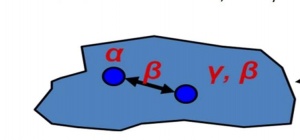Objectives
Objectives: This course offers an overview of the different ways to measure biodiversity, and provides tips for the stratification of primary biodiversity data and the construction of variables that describe its various facets. It also includes an in-depth review of the different types of data used to measure biodiversity and their problems and limitations.
Overview: Biodiversity is a complex phenomenon that includes many different facets and functions, covering a wide array of ecological and evolutionary characteristics. In spite of this most studies on biodiversity focus on species richness and, to a lesser extent, on the variation in species composition or the diversity of evolutionary processes. Because of this, many facets of biodiversity are poorly known. In addition, knowledge about the geographical distribution of the biota is incomplete and spatially and taxonomically uneven. The problems of biodiversity data hamper studying the determinants of diversity gradients, and limit their usefulness in conservation planning.
During the course we will describe the facets of biodiversity that are commonly studied, with an emphasis on ecological and species diversity. This includes richness, composition, replacement (beta diversity), rarity, endemism, phylogenetic diversity and functional diversity. We will also review the different ecological functions that have been assigned to some of these facets, their possible role in ecosystem functioning, and the relationship between biodiversity and some ecosystem services that are essential to the functioning of the biosphere.
Throughout the course we will focus on how to measure biodiversity, with special reference –but not limited– to its geographical and temporal variations. I will review the various sources of information about biodiversity, as well as its accessibility and/or potential utility. We will discuss how to use this information to measure different facets of biodiversity. After that, we will review current shortfalls in biodiversity data. We will describe various sources of bias and/or lack of knowledge associated with these data and measures, their origin, and the effects they have on the knowledge of biodiversity.
Finally, we will discuss the different ways to correct or mitigate the limitations imposed by these shortfalls, namely additional sampling, diversity estimators (of richness and composition), and predictive models of the geographic distribution of both species and different measures of diversity. We will overview the methods available for these strategies, as well as their logical order of application and its usefulness in terms of specific objective of the study and the type of data available. We will use several practical examples – including the students’ own work – to discuss about (1) how to decide the most appropriate sampling plan, (2) assessing survey quality, (3) using estimates, (4) how to stratify data, and (5) developing and validating predictive models of geographic distribution. Finally, we discuss the usefulness of the data and methods currently available for the study of diversity gradients, community ecology and conservation planning.
Participants have to be present at 85% of the contact hours (this means that they can miss one half-day), and actively participate in all activities.
This course can have a recognition of 6 ECTs for FCUL PhD students enrolling in it as part of their first doctoral year. These students need to deliver two reports after the course. For students only requiring 5 ECTs recognized in their specific PhD programmes the last 3.5 hours of the course are not mandatory, they need to deliver only the main report and the certificate will be on 'Topics in Measuring Biodiversity’. Such report(s) are also advised for other students requesting creditation of the course in their institutions.
Minimal formation of students: “Licenciatura” (bachelor) in Biology, Environmental Sciences, Geography or related areas.
Directed to: PhD or MSc students in Ecology, Geography or related areas, and postdocs and other professionals working in related topics
General Plan
Plan:
- Course Introduction - Biodiversity, concept and types: genetic diversity, ecological and specific - Facets of Biodiversity.
- Measures of species diversity: richness, composition, substitution (beta diversity), rarity, endemism.
- Phylogenetic and functional diversity.
- Species traits and functional groups.
- Stratification of biodiversity data.
- Main shortfalls in biodiversity data.
- Databases, data quality and bias.
- Sampling effort evaluation.
- Species richness estimators.
- Survey design.
- Species distribution models: theory, utility and limitations.
- Measuring and communicating uncertainty associated to data quality. Maps of biogeographical ignorance.
Funding
Students fees
Partners
n.a.
Fee
Free for 1st year PhD students in Doctoral programmes at FCUL (e.g. Biologia), Biodiversity, Genetics and Evolution (BIODIV UL; UP), Biology and Ecology of Global Changes (BEAG UL, UA) and Sustainability Science (UL, several institutions), when the course counts credits for their formation, in which case the delivery of a final report done after the course is mandatory; the course is also free for more advanced PhD students of the BIODIV programme (ULisboa or UPorto); 50 € for more advanced PhD students of cE3c of other programmes; 80 € for PhD students of the PEERS network (CFE); 125 € for FCUL Master students and unemployed; 180 € for BTI, BI and other PhD students; 250 € for Professional and postdocs.
When the maximum number of students is reached, 10 vacancies will be available for non-paying 1st year PhD students mentioned above, being, by order of preference students from: 1) cE3c; 2) BIODIV (not from cE3c); 3) FCUL (not from cE3c); 4) Sustainability Science (not from cE3c or FCUL); 5) BEAG (not from cE3c or FCUL).
Candidates should fill in the following FORMULARY:
(closed)
This formulary is strictly confidential, as explained in the introduction, and the data are required because the cE3c Advanced Courses are also offered as part of the PRR programme of FCUL.
When filling the formulary mind to:
- FILL ALL THE MANDATORY FIELDS
- UPLOAD CV AND MOTIVATION LETTER, both mandatory; use the names as instructed there
- If you want to resume later SAVE the formulary, otherwise you will need to fill everything again
- At the end SUBMIT the formulary before exiting
For any doubts please contact the cE3c coordinator of the cE3c courses Margarida Matos, email mmmatos@fc.ul.pt
jhortal@mncn.csic.es

